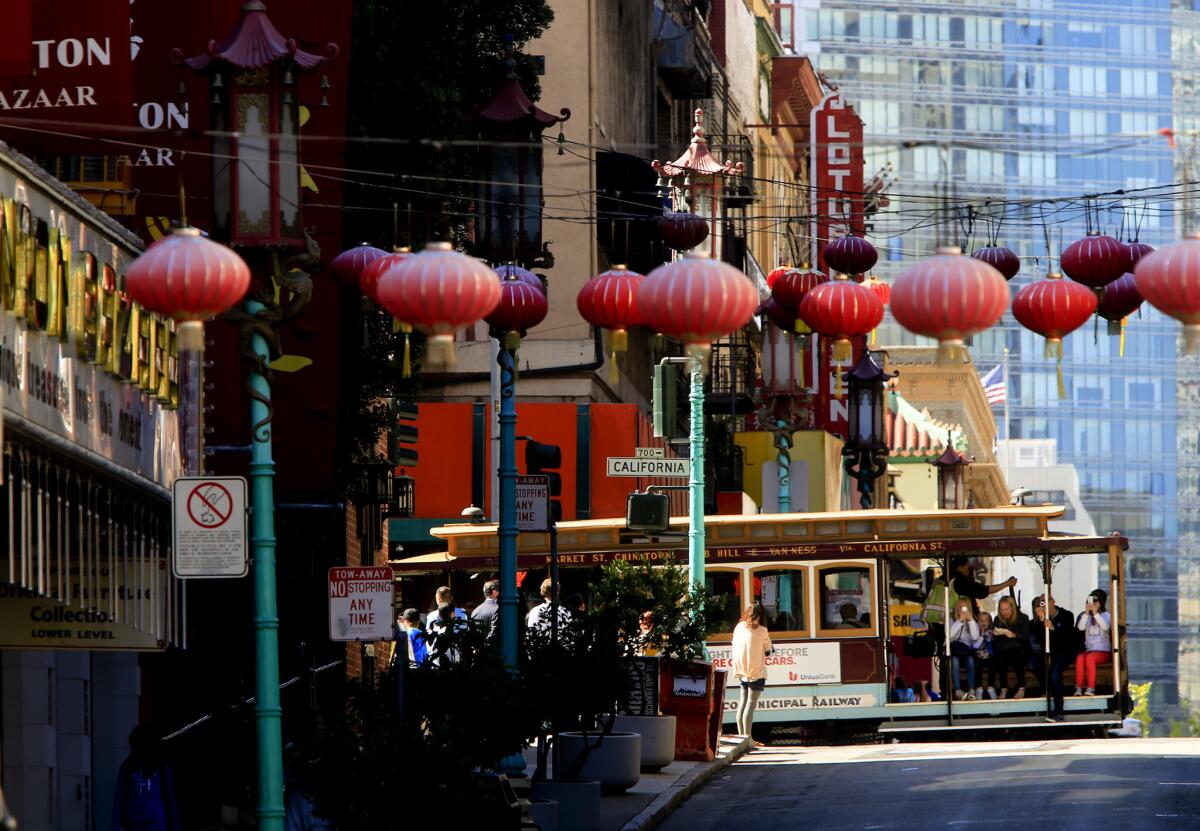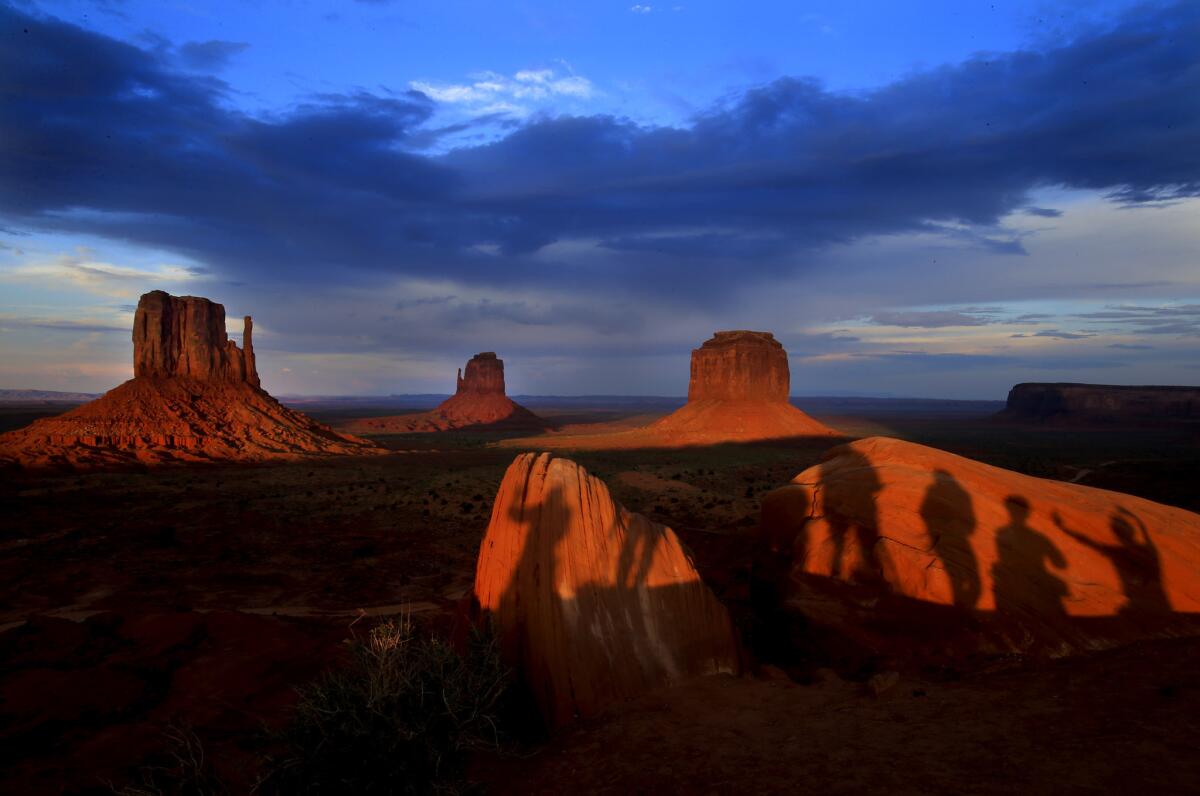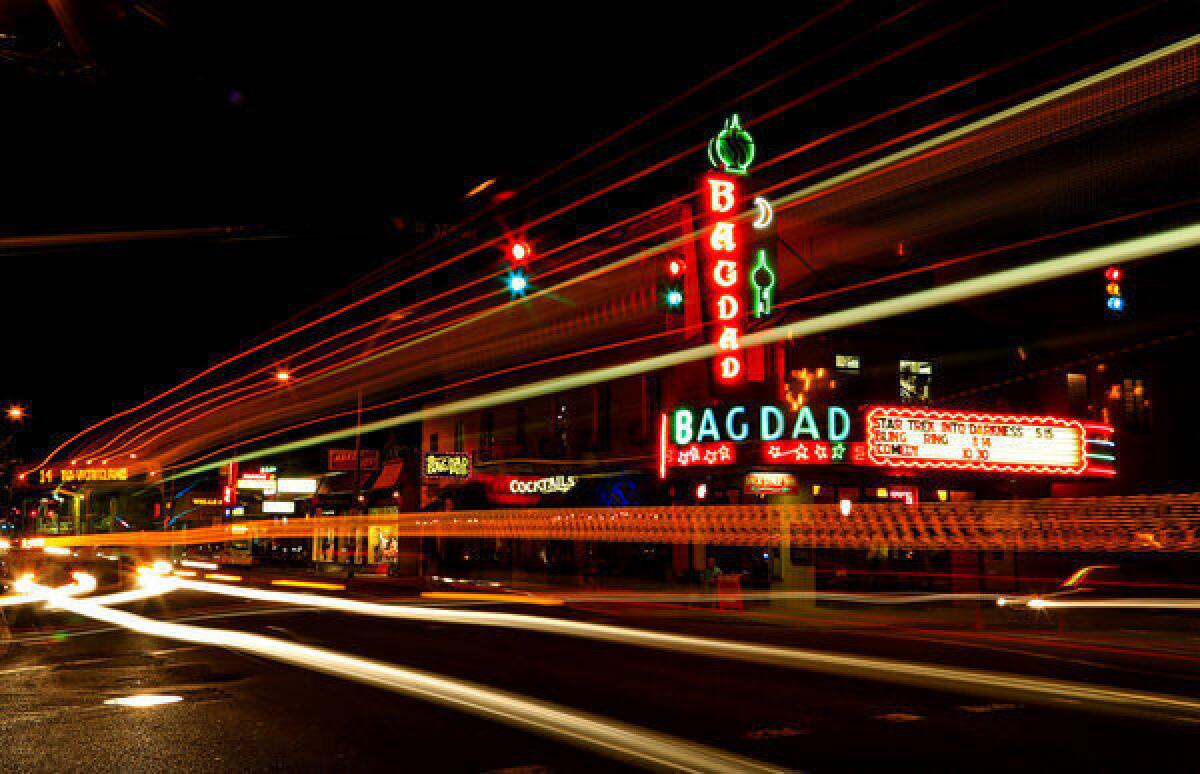San Francisco’s famed cable cars
The expensive and outdated mode of transportation remains the heart of San Francisco.
- Share via

The oohing and ahhing over the world's only remaining manually operated big-city cable car system will begin shortly. But first, let's admit a few things:
That rats congregate near the cable car turntable by Ghirardelli Square. That panhandlers still plague the gritty turntable at Powell and Market streets. That $6 a ride would be one of the worst public transit bargains in the West, if these cars were really about public transit. That some conductors and gripmen are as rude as the hills are steep. That for prompt cross-town travel in daylight hours, the Powell Street lines are about as practical as a Ferris wheel.
Yet as many a San Franciscan can tell you, the heart wants what the heart wants. And our tourist hearts want cable cars. The ringing bell. The wind in our hair. The first sight of Alcatraz as we crest Russian Hill. The heavy scent of lubricated machinery navigating a 15% grade. The humming street and nervously grinning first-timers. I know now that this three-line system costs about $30 million per year more than it earns, but that old Rice-A-Roni jingle just keeps playing in my head.
And so, to sort these feelings and facts, photographer Mark Boster and I are riding every line, morning, noon and night.
Now it's a busy June morning at Powell and Market, and we're in line to board. In the first five minutes of our 20-minute wait, we meet six panhandlers and a busker serenading families with that old Ramones favorite "Beat on the Brat." Then we board, and the car lurches ahead. Union Square flashes past on the right, the Westin St. Francis Hotel on the left. Giddy tourists clutch their kids, abandon their personal space to stand knee-to-knee with a sitting stranger, snap self-portraits and wave at the sidewalk hordes. A woman from out of town tries to convince the conductor that he has undercharged her.
"Are you going to tell me how to do my job?" the conductor asks, flashing a grin that might be playful or condescending. "Would you like to drive the car next?"
Later, cresting Russian Hill at Lombard Street, that conductor yanks the brake.
"Crookedest street in the world!" he calls out. "Unless you count Wall Street!" To our right, Lombard Street's gardens bloom in Technicolor. Beyond, Telegraph Hill and Coit Tower. Alcatraz is dead ahead.
About 20 minutes after starting, we roll up to the Powell-Hyde turntable in grassy Victorian Park. There, hundreds more tourists await their turns (and have been waiting longer than their ride will last). On a day of mild weather, who can name a prettier place to stand in line?
Yet hours later, as the evening deepens and another crop of passengers waits, a rat scurries from the bushes past the feet of a guitarist playing "Hotel California." Then another one (rat, that is) dashes across the tracks.
"This is the rat kingdom," one cable car gripman tells me. In the headquarters of the San Francisco Maritime National Historic Park, which controls the space, public affairs officer Lynn Cullivan acknowledges the "ongoing struggle" between man and wharf rat.
The San Francisco Municipal Transportation Agency operates 40 cable cars. They roll on three lines — Powell-Hyde, Powell-Mason and California Street — that together cover 8.8 miles. They top out at 9.5 mph. Starting just before 6 a.m. and stopping between 1 and 2 a.m., they board about 19,000 passengers a day.
To digest these numbers properly, we head for Mason and Washington streets, where a big, old brick building harbors the spinning wheels and humming machines that keep the cables and cars moving. This landmark, skirted by the Powell-Hyde and Powell-Mason lines, is the nerve center of the cable car system, also known as the powerhouse and the car barn. One floor is dedicated to a free Cable Car Museum, where you can see the only remaining car from the city's original 1873 cable car line, buy a 3-inch length of retired cable for $34.99 or look down on the spinning, roaring innards of the system.
That's one way to take in the big picture. Another is to nurse a coffee at Caffé Cento at Powell and California streets atop Nob Hill — the only corner where all three lines converge. This is the spot where I realized that if cable cars hadn't been born here, H.G. Wells and Jules Verne would have jointly hallucinated them between midnight sips of absinthe on a Montmartre rooftop.
If you have time for only one ride, take the Powell-Hyde line, which is the longest and the one with the Alcatraz and Lombard Street views and the turntable near Ghirardelli Square. Traveling northbound, cars turn left on Jackson Street and right on Hyde. (To admire the maneuver from a stationary point, hop off at 1500 Hyde St. and have a glass of wine by the big windows of Nook.) Alas, the Powell-Hyde is also the most crowded line. After this trip, I may never attempt it between 9 a.m. and nightfall.
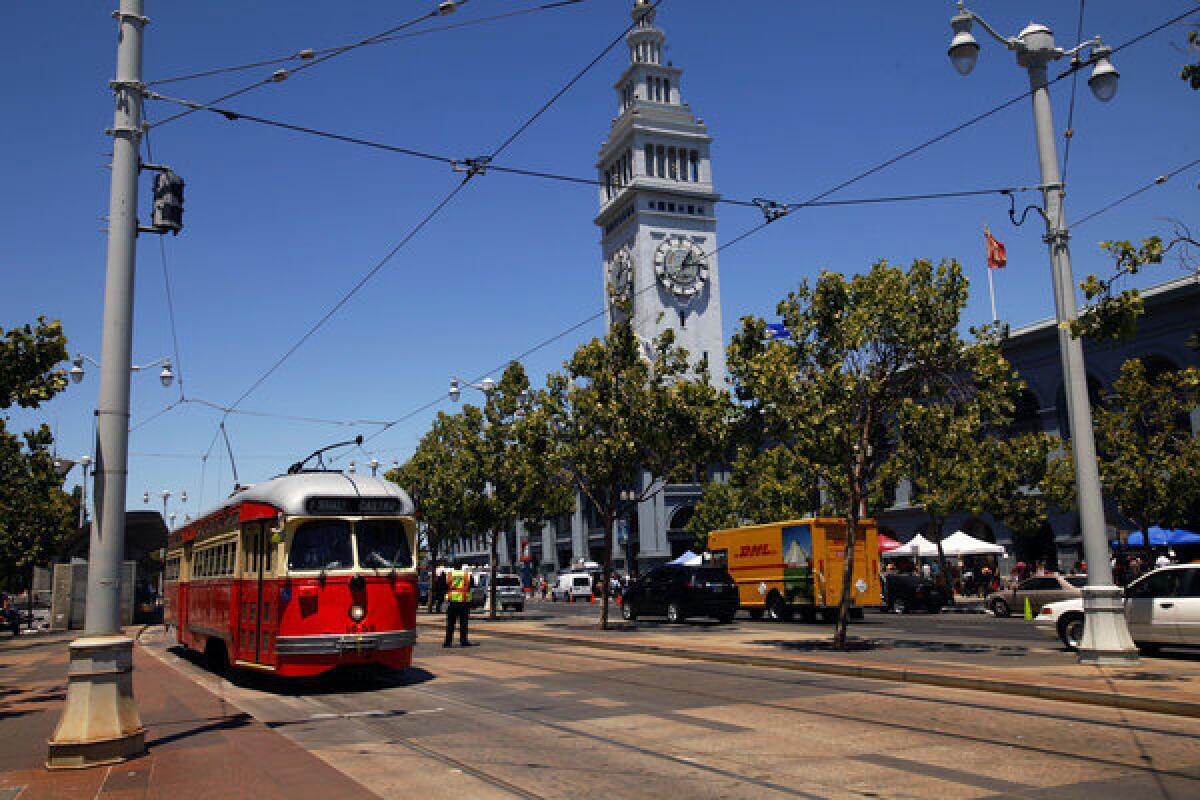
A brightly colored trolley cruises down the Embarcadero past the Ferry Building in San Francisco. ( Mark Boster / Los Angeles Times ) More photos
The Powell-Mason line, Powell-Hyde's nonidentical twin, starts at the same gritty Powell-Market turntable, climbs Nob Hill, jogs left at Jackson and straightens again at Mason Street. But the journey ends with a whimper, not a bang — no Alcatraz, no Lombard, just a turntable at Bay Street, near the soul-numbing souvenir shops of not-quite-waterfront Fisherman's Wharf.
That leaves the line that many tourists miss — the California Street line, an East-West beeline between Van Ness Avenue and the Financial District. It needs no turntable because its cars are designed differently. It often carries more commuters than tourists. From Nob Hill, you can gaze down a canyon lined by skyscrapers to the distant swoop of the Bay Bridge. You could hop off at 240 California St. for seafood and nostalgia at the Tadich Grill, maybe the city's oldest eatery.
But if you're a trainspotter, you may prefer to hop off in Chinatown, as I did one morning, and walk two blocks north to Clay Street. Now, take a good look up and down and notice the lack of magic.
This was the route that cable car inventor Andrew Smith Hallidie chose for the first line in 1873. It climbed Clay from Kearny Street, eventually reaching Van Ness, at grades of up to 16%. It's long gone, of course. And the rest of the cable cars would be gone too, if transit logic ruled the day. Luckily for us, San Francisco knows it's in the business of being pretty, and the cable cars are the twinkle in its eyes.
The cable car is dead. Long live the cable car.

Timeline: A history of cable cars in San Francisco
Since Andrew Smith Hallidie opened the first line in 1873, the cable car lines have endured cheaper streetcars, earthquakes and politicians.
1873 Andrew Smith Hallidie, a British immigrant and failed gold miner, opens the first cable car line in the U.S., the half-mile Clay Street Hill Railroad, which surmounts Nob Hill. Using machinery inspired by mining tools, Hallidie's cars climb Clay from Kearny Street by clamping on to a continuously moving loop of steel cable, which is powered by coal-fed engines in a powerhouse. As Hallidie later writes, "It does not frighten horses or endanger lives."
890s Cable cars run on California Street, Clay Street, Columbus Avenue, Geary Street, Market Street and others — but most are doomed. Across America, faster and cheaper streetcars (powered by overhead electric wires) are taking over.
1906 The San Francisco earthquake and fires lay waste to the city. In reconstruction, many cable car companies switch to streetcars. A handful of cable car lines endures.
1947 Mayor Roger Lapham, a big believer in buses, declares that "the city should get rid of all cable car lines as soon as possible." Activist Friedel Klussmann disagrees, starts a Citizens' Committee to Save the Cable Cars and wins passage of a ballot measure to protect part of the cable car system.
1958 The pasta-making DeDomenico family of San Francisco, inspired by a neighbor's old Armenian recipe, combines rice and macaroni and calls it Rice-A-Roni. Somebody writes a jingle about "the San Francisco treat." A TV ad campaign with cable cars is launched and lasts into the '90s.

A present-day photograph of a cable car contrasted with a postcard of on a Turntable at Powell and Market Streets. (Color image: Mark Boster / Los Angeles Times)
1962 Road & Track magazine, best known for its car reviews, runs a tongue-in-cheek review of "the ultimate town car … upholstered throughout in wood," with an unladen weight of 8 tons. In other words: a cable car on the Powell-Hyde line.
1982 Cable car service, run by the San Francisco Municipal Transportation Agency (Muni), is suspended for two years as authorities begin rehabilitating an old and faltering system.
1984 The cable cars return to service with a parade up Powell Street led by the U.S. Marine Corps band. The system now has three lines covering 8.8 miles.
1997 The Powell-Hyde line turntable, near Ghirardelli Square, is renamed for Friedel Klussmann.
1998 Fannie Mae Barnes, a 52-year-old single mom with notable upper-body strength, becomes the cable car system's first female grip operator.
2013Associated Press finds that in the last 10 years, the city's cable cars have been involved in 126 accidents, with 151 people injured and no fatalities. AP cites about four dozen legal claims and settlement payments of nearly $8 million. About 7 million passengers board cable cars yearly.
Sources: San Francisco Municipal Transportation Agency; Cable Car Museum; sfcablecar.com; Rice-A-Roni

San Francisco's streetcars: Where history meets convenience
The colorful vehicles are a quick and cheap option to cable cars, and there's plenty to see along the routes.
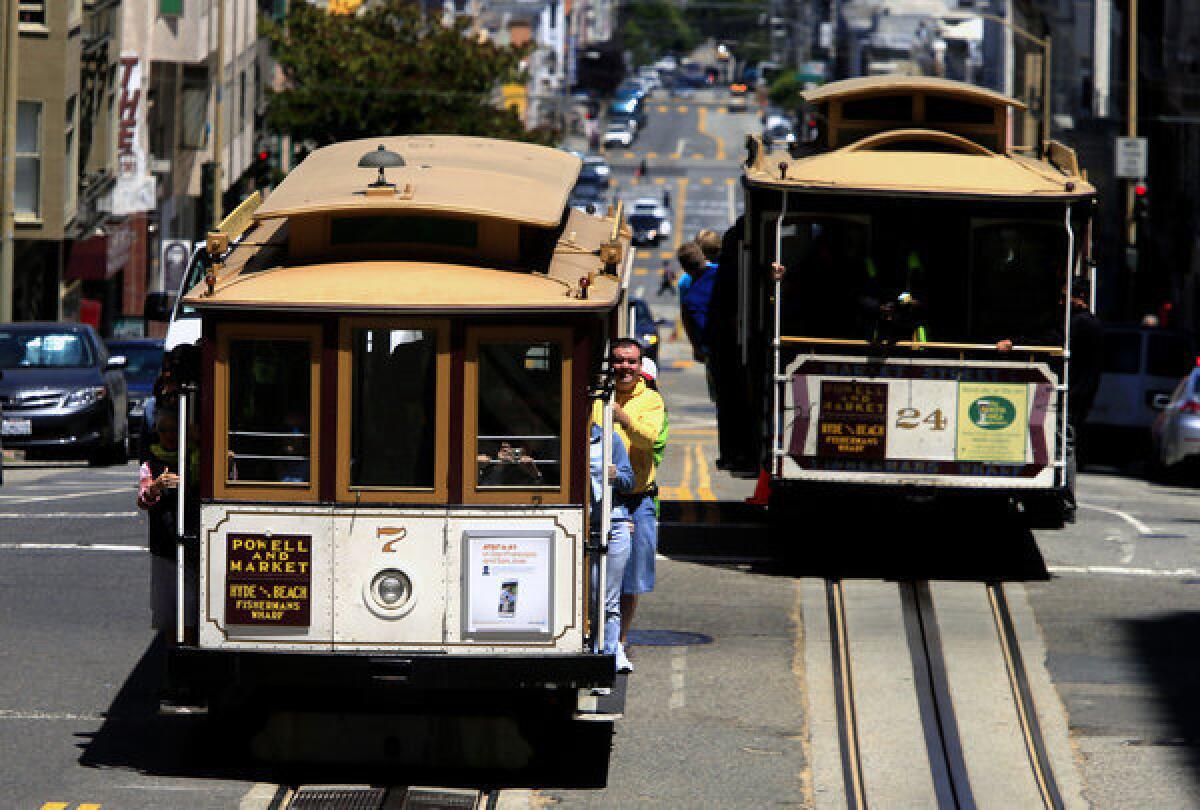
Cable cars on the Powell and Market line pass each other. (Mark Boster / Los Angeles Times) More photos
They have no Rice-A-Roni jingle, but the streetcars of San Francisco are worth knowing. Their six-mile route (also known as the F Market & Wharves line) is shaped like a 7, with the Ferry Building at the elbow joint.
You can ride them along the Embarcadero between Fisherman's Wharf and the Ferry Building. Or you can take them down Market Street to the Castro District. A streetcar holds more people, rolls two or three times as fast and costs far less — $2 per ride — than a cable car.
Like the cable cars, the streetcars date to the 19th century. Since the system's resurrection in the mid-1990s, transportation officials have outfitted the fleet of 20th century streetcars with color schemes that pay homage to long-ago streetcar systems around the world. (Yes, the old Pacific Electric cars of Southern California are represented.)
You'll get more history at the free San Francisco Railway Museum & Gift Shop (77 Steuart St.; (415) 974-1948). And don't miss the 12-minute film of a cable car (before streetcars took over) rolling up Market Street from 8th Street to the Ferry Building on what seems an unremarkable day in 1906. In fact, the footage was shot just days before the great quake and fires ravaged most of the city.
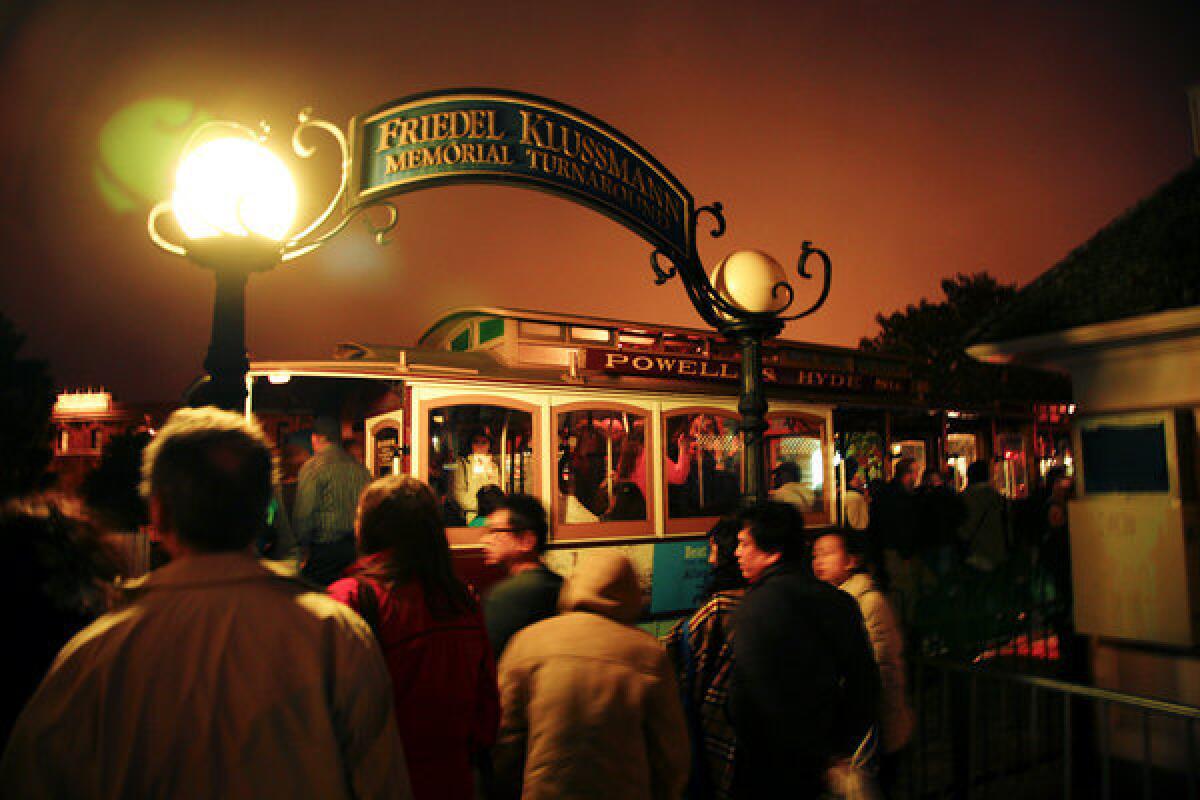
Riders wait at the Friedel Klussmann Memorial Turnaround in San Francisco. (Mark Boster / Los Angeles Times) More photos
Unlike the cable cars, the streetcars (especially on Market Street) are heavily used by locals, which means they can fill up fast. If you're riding between Fisherman's Wharf and the Ferry Building, you'll see the Exploratorium (Pier 15/17; (415) 528-4444), which relocated in April. At Pier 27 and Pier 29, you'll see a batch of stylish structures associated with this summer's America's Cup sailing competition.
At the Ferry Building itself, you'll encounter fancy food of all stripes. One great affordable option is Mijita (1 Ferry Building, No. 44; (415) 399-0814), which offers Mexican street food with seasonal ingredients. Great mushroom quesadillas with equally great salsa. Nothing more than $8.
If you're headed down Market Street to the Castro, brace yourself for a journey from affluence to desperation to affluence again. Though redevelopment is said to be on the march and a couple of new apartment buildings are going up, there's still plenty of blight and menace between Powell Street and the burst of rainbow-hued shops, bars and restaurants that herald your arrival in the Castro.
Rick Laubscher, president of the nonprofit Market Street Railway (which promotes the system while the San Francisco Municipal Transportation Agency runs it), estimates streetcar ridership at 20,000 to 25,000 per day. That, Laubscher says, "makes it the most popular traditional streetcar line in America.... We carry more people than all four of New Orleans' streetcar lines put together, and we carry more people than all three of San Francisco's cable car lines put together."

An insider's view of San Francisco cable cars
Trini Whittaker is a veteran conductor who considers the cable cars rolling theater — only with danger always near.
Trini Whittaker, veteran conductor and grip operator on San Francisco's California Street cable car line, sometimes welcomes passengers this way:
"OK, the black guy doesn't die early in this movie. So you're all safe."
And sometimes this way: "I didn't really take my medication today, so you guys might want to hold on tight for the hills."
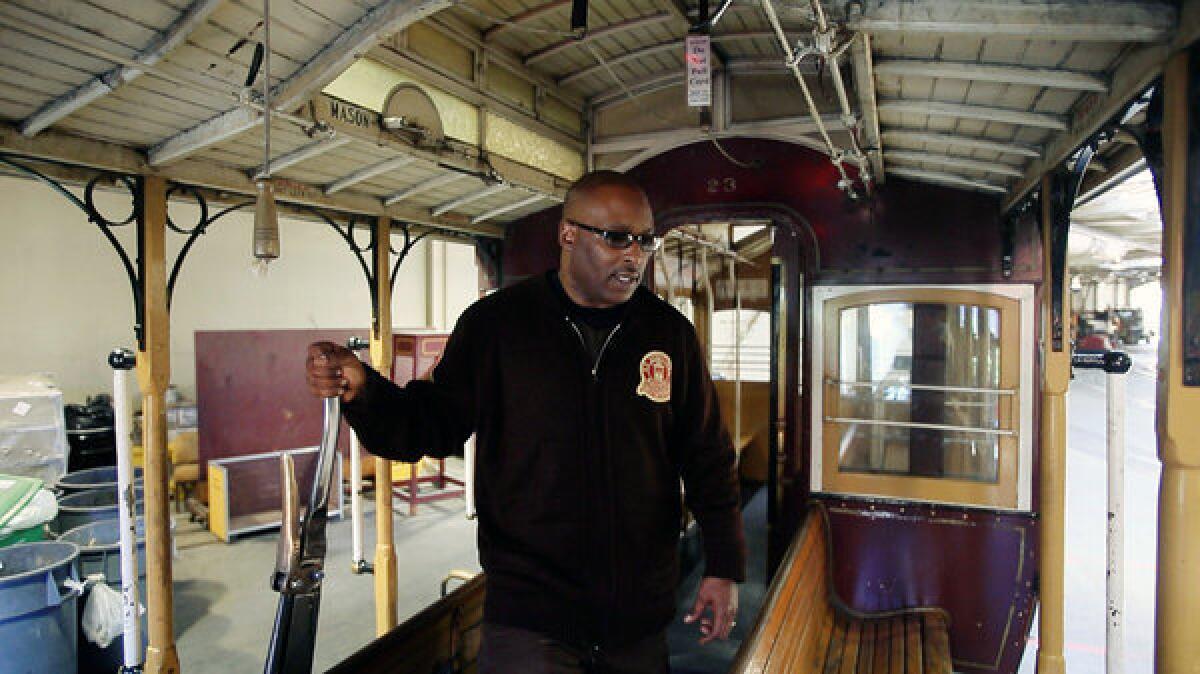
Trini Whittaker, veteran conductor and grip operator on San Francisco's California Street cable-car line, sometimes welcomes passengers this way: "OK, the black guy doesn't die early in this movie. So you're all safe." In other words, Whittaker, 46, understands that cable-car travel is theater. ( Mark Boster / Los Angeles Times ) More photos
In other words, Whittaker, 46, understands that cable car travel is theater. Also a team sport, a rolling history lesson and, if you're not on the ball, an accident about to happen. But when he was a kid in a public housing project at the end of the Powell-Mason line, Whittaker says, "it was just transportation."
Then he grew up and started driving 40-foot diesel buses, 40-foot trolley buses, 60-foot trolley buses and finally cable cars, which are far more challenging than their 9.5 mph maximum speed might suggest. Besides upper-body strength, the job demands intense "physical and mental coordination," in the words of David Banbury, superintendent of Muni's cable car division. The cable car training course's "washout rate," Banbury says, is 75%.
The greatest danger? Whittaker says it's fare-hungry taxi drivers who swerve across lanes to the curb. Grip operators and conductors also worry about the condition of the cables just under street level (they fray and need replacing regularly), scofflaw passengers who jump on and off cable cars while they're moving, clueless or aggressive pedestrians, clueless or aggressive drivers, and other cable cars, which pass just a few feet away.
On the most congested and touristy stretch of Powell Street, near Union Square, says Whittaker, "you have to be able to deal with seven or eight things at a time," which might explain the cranky manners of some crews. Meanwhile on the California Street line, riders tend to be savvier locals; in fact, many try to ride without paying.
Whittaker sidesteps questions about his colleagues' manners, but he's happy to talk about the city cable car bell-ringing competition, which he won last year. Demonstrating old-school and new-school styles, Whittaker first works the bell like a jazz drummer riding a cymbal, then segues into a hip-hoppy dance beat.
And yes, he has carried some famous passengers. Former 49ers Joe Montana and Ronnie Lott, for instance. Yankees star Alex Rodriguez. Once, Whittaker says, "I had Woody Allen on the cable car. But even when I said, 'Hey, we have Woody Allen on board!' nobody would believe me."
Sign up for The Wild
We’ll help you find the best places to hike, bike and run, as well as the perfect silent spots for meditation and yoga.
You may occasionally receive promotional content from the Los Angeles Times.
